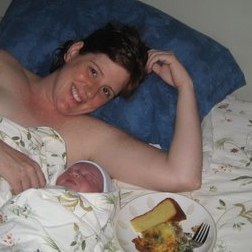By Amy Romano
I have two kids, and they were both born at home. My births were almost carbon copies of each other. My daughter and son were both born at 39 weeks and 4 days, labor started with water breaking, contractions followed about 30 minutes later, and then labor progressed very quickly. I had a second degree tear both times in the same spot (ouch), and experienced urinary retention and required a straight catheter both times (double ouch). It’s weird, I know – most women don’t have two kids with such similar births.
There was one major difference, though. At my second birth, my midwives could have been arrested just for being there. They were Certified Professional Midwives (CPMs) with a combined 30+ years of experience but the state I lived in at the time didn’t recognize this national credential. Neither do 22 other states. Some states actively criminalize home birth midwifery while others have outdated statutes that simply don’t recognize CPMs. But the impact is the same: it marginalizes midwives from the very system that optimizes the safety of home birth: the care providers and facilities that can intervene when complications develop.
I was fortunate that I didn’t need this safety net. But had I encountered problems in my first birth, the procedure was clear: My midwife would have called the obstetrician she worked with, who I had already met during a routine 36 week visit, and she would have accompanied me to the hospital, freely sharing the information in my medical record, giving a verbal report to the doctor, and staying by my side to provide continuous emotional support and comfort. My prenatal record and labs would already have been at the hospital and the doctor would prepare whatever resources and staff were necessary based on the report she got by phone from my midwife – whether that was an epidural for pain relief or a crash c-section.
Had the same complication arisen in my second birth, I honestly don’t know exactly what would have happened. I was lucky that the doctor who backed-up the birth center practice where I worked at the time was willing to do a “special favor” and be my back-up doctor for my own birth. He didn’t do this for other women planning home births. There were a few other doctors in the surrounding areas who would provide “parallel care” to women having home births, which would have meant going to double the number of prenatal visits even though I was healthy, had a toddler at home, and a full-time job. And I’d have to travel a good 30-45 minutes for those prenatal consults, since those doctors weren’t right in my community. I probably would have declined to bother with this since, given my history of rapid labors, I knew it was unlikely that I’d even make it to a hospital 30 or 45 minutes away, and would end up going through an ER closer to home for my care. As for my midwife, she may or may not have been able to transparently share the records from care up to the point of transfer, and she may or may not have been able to stay by my side. It probably would depend on the circumstances of the transfer and whether the receiving hospital was hostile toward or accepting of home birth midwives. After all, she could end up in jail just for bringing me there, even if by doing so she saved my life or my baby’s life.
If ever there was a disincentive to provide safe care, this is it: the fear that by securing access to proper treatments, the midwife faces the possibility of incarceration, loss of livelihood, and financial ruin. And the irony is that in many of the cases where midwives get into trouble, the baby and the mother turned out healthy. In other words, the midwife initiated a transfer appropriately and in a timely manner and the system – as fragmented as it is – actually worked to achieve a good outcome. But all it takes is one person to lodge a complaint, even if the woman herself is happy with her care, and the house of cards comes tumbling down.
Who benefits from this way of doing things? We’ve already seen that women, babies, and midwives don’t. I don’t really believe that doctors or hospitals benefit, either. Instead of having an orderly system for receiving referrals, staff have to piece together the bits of information in the moment, while caring for a patient who probably doesn’t want to be there and has just been separated from the care provider with whom she has built up nine months worth of trust. The state doesn’t benefit, either. When my son was born safely at home, my husband signed the birth certificate. In other words, the state can’t track the outcomes of practicing home birth midwives, but is called on to investigate when a member of the public makes a complaint.
Many women, I presume, approach the situation the way I did: ignorance is bliss. I didn’t really want to hear the answers to the hard “what if” questions, so I didn’t dwell on them. Besides, I didn’t really have any other options. The only other midwifery practice in my community was the one I worked at, and I preferred to keep my personal and professional lives separate, and I knew enough about the hospital in my community to know that I didn’t want to give birth there unless it was the only safe place to be. I assumed because I was healthy and had already given birth at home, everything would probably turn out fine. I knew my midwives were competent and caring and would do everything possible to keep me out of harm’s way. But I didn’t really know how my care would unfold if I needed urgent help that was outside of my midwives’ scope of practice or skill set. I put trust in a system that couldn’t have been more dysfunctional, and I was lucky that, in the end, I didn’t need to rely on it.
This post is part of a blog carnival to raise awareness about Dr. Agnes Gereb, a Hungarian gynecologist and midwife who was jailed for attending a precipitous birth at her birth center in Budapest, despite apparently providing proper care and exhibiting swift judgment.




 ....
....
